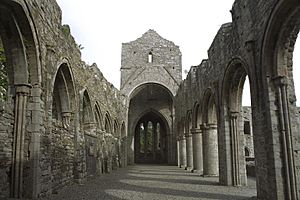John King (died 1637) facts for kids
Sir John King (born around 1560, died January 4, 1637) was an important person in Ireland. He was an Anglo-Irish administrator, which means he helped manage the government. He was also a politician, serving in the Irish House of Commons, which was like a parliament. Plus, he owned a lot of land.
Sir John was a trusted helper for the English Crown (the King or Queen of England) in Ireland. Many people thought he was one of the best public servants of his time. He had several children who became famous in their own ways. His family line eventually led to the Earl of Kingston.
Contents
Sir John King's Career and Public Service
We don't know much about where John King was born or who his parents were. Most people think he was born in Yorkshire, England, probably in a town called Northallerton.
He first came to Ireland in 1585. He worked as a secretary for Sir Richard Bingham, who was in charge of the Connaught area. Queen Elizabeth I was happy with his good work for the English Crown. She gave him the right to use Boyle Abbey and made him the Constable of Boyle. This meant he was in charge of a small group of soldiers there.
John King started building a castle in Boyle and helped settle the area around it. His family stayed connected to the town of Boyle for hundreds of years. John lived in Boyle and also had a house in Dublin, near where Baggot Street is today.
Working for King James I
When King James I came to power, John King was known as a very useful and skilled public servant. He held many important jobs that helped him earn money. By the end of his life, he owned land in twenty-one different counties!
From 1603, he had a job called Clerk of the Crown and Hanaper for his entire life. This job involved managing important government documents. From 1606, he shared this job with Francis Edgeworth. Francis was an ancestor of the famous Edgeworth family, which included the writer Maria Edgeworth.
In 1603, John King also became a Receiver of government money. Later, he became the Deputy Vice-Treasurer of Ireland, helping to manage the country's finances. In 1609, he became the Muster-master for Ireland and Clerk of the Cheque. These roles involved checking on soldiers and payments. He also became a Commissioner for Compositions in 1611, dealing with land agreements.
Important Government Roles
Sir John King was part of groups that helped with the Plantation of County Wexford and County Longford. Plantations were when English and Scottish settlers were given land in Ireland.
In 1611, he became a Commissioner of the Irish Court of Wards. This court managed the property of young people who had lost their parents. He also served on the Council of Munster, which was another part of Ireland. At different times, he was allowed to act as a temporary governor for Connacht, Leinster, and Ulster.
In 1609, he was made a knight, which gave him the title "Sir." He also became a member of the Privy Council of Ireland. This was a group of important advisors to the King. In the Parliament of Ireland from 1613 to 1615, he was one of two Members of Parliament (MPs) for County Roscommon.
Sir John King's Family Life
Before 1599, John King married Catherine Drury. Catherine's father, Robert Drury, had come to Ireland with his uncle, Sir William Drury, who was the President of Munster. Catherine's mother, Elizabeth Carew, was likely born in Old Leighlin in County Carlow.
Catherine King passed away in 1617. She and John had nine children. Several of them became quite famous. All three of their daughters, especially Dorothy, were known for being very well-educated for their time.
His children included:
- Sir Robert King (died 1657), who also became a Member of Parliament.
- Edward King (1612-1637), a poet and a friend of the famous writer John Milton. Milton wrote a poem called Lycidas to remember Edward after he sadly drowned at a young age.
- John King, who married Margaret Edgeworth (died 1676). Margaret was the daughter of Francis Edgeworth, who worked with John King in the Hanaper office. After John's death, Margaret married John Bysse, a very important judge.
- Dorothy Dury (around 1613-1664), who was a well-known writer about how to educate women. She married twice. Her second husband was John Dury, a leading preacher from Scotland.
- Mary King (died 1663), who married William Caulfeild, the 2nd Baron Charlemont.
- Margaret King (died 1658), who married Sir Gerard Lowther, who was a very important judge in Ireland.
Death
Sir John King died in Lichfield, England, in January 1637. His body was brought back to Boyle, Ireland, to be buried. This was apparently against his own wishes, as he had wanted to be buried in Lichfield.


